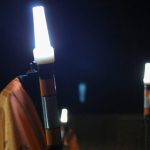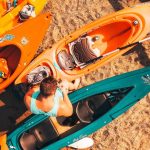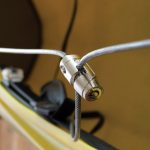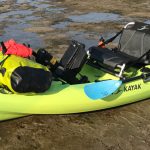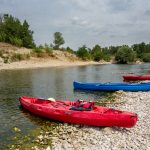Can you paddle after dark? Yes, with a good set of kayak lights. We explore the best lights on the market and some laws and regulations.

Let’s be honest: there are few things that make you feel like more of a badass adventurer than kayaking at night!
It doesn’t matter if you’re paddling around a local bay, navigating a slow-moving river, or just enjoying the calm waters of your favorite lake—because it’s dark, starry, and quiet, it feels like something straight out of an action (or horror) movie.
There’s something almost magical about being alone on the water, with nothing but the moon and stars for company.
Of course, for all its perks, kayaking at night does come with its own inherent risks, which you absolutely need to be prepared for!
Below, we’re going to talk about everything you need to know about kayaking at night: whether or not it’s legal, how dangerous it is, and what you need to keep you safe on the water. We’ve even got some simple, practical tips to help you kayak at night like a boss.
By the time you finish reading this post, you’ll be ready for a safe, delightful night kayaking adventure.
Is it Legal to Kayak at Night?

Of course we’re going to start off by asking (and answering) this question! After all, the last thing you want to do is inadvertently break the law and get fined for doing something you thought was fully legal.
Good news: kayaking at night is 100% legal in both the U.S. and Canada!
There may be some states, provinces, or even cities that have specific regulations prohibiting night kayaks in certain areas—for example, in privately owned and operated waterways—but on a broad scale, kayaking at night is fully legal.
Some U.S. and Canadian National Parks may close their gates to traffic at a certain time of day, but if you’re camping inside those parks, you’re fully legal to operate a kayak on the water (unless the park specifically prohibits it).
Really, the only thing that regulates night kayaking is the U.S. Coast Guard’s Rule 25.
In it, the rule states:
(i) A sailing vessel of less than 7 meters in length shall, if practicable, exhibit the lights prescribed in paragraph (a) or (b) of this Rule, but if she does not, she shall exhibit an all-round white light or have ready at hand an electric torch or lighted lantern showing a white light which shall be exhibited in sufficient time to prevent collision.
(ii) A vessel under oars may exhibit the lights prescribed in this Rule for sailing vessels, but if she does not, she shall exhibit an all-round white light or have ready at hand an electric torch or lighted lantern showing a white light which shall be exhibited in sufficient time to prevent collision.
(Information courtesy of Cornell Law School)
Your kayak is definitely less than 7 meters long, but because of its paddle, it is considered “under oars”. So, according to this law, you have to exhibit the light: an all-round white light, or, in a pinch, an electric torch or lighted lantern with a white light. As the law states, it’s done to prevent collision with other vessels.
Well, isn’t that nice and easy? If that’s all you legally need to paddle at night, that’s a simple problem to solve.
You just buy a white kayak light!
We’ve done the research to help you find the absolute best lights for your paddling trips, along with all the information to help you choose the light that is easily mounted on your specific kayak, runs the longest, emits the most light, and has all the built-in extra features (like strobe for emergencies, and red/green lights to signal your port/starboard sides) you’ll want.
Read our article on 10 Best Kayak Lights for Night Fishing & Paddling and go over our carefully curated selection of water-legal kayak lights and the complete guide to using a kayak light.
With that, you’re ready to hit the water!
Is it Dangerous to Kayak at Night?
No article about night kayaking would be complete without discussing the potential dangers of this activity.
Because if we’re being honest with ourselves, as much fun as night kayaking sounds, there are real dangers. It’s why so few people go night kayaking in the first place, instead preferring to do their paddling during the day.

Here are a few of the greatest concerns to be aware of, the real potential threats to your health and safety:
Getting lost – Yes, getting lost is a very real possibility at night! Whether you’re paddling on a lake, river, or the ocean, you have no visible markers to guide you back to the shore—or, more accurately, back to the place where your tent is pitched or your vehicle is parked. You could spend hours paddling along a dark, unlit coastline trying to make your way back home. (Of course, a simple solution is to set up lights to mark your launch point.)
Now, picture yourself trying to paddle downriver and navigate various channels and interweaving waterways. It’s easy to make a wrong turn and head down a path that leads you way off-course. And when you’re dealing with an entire ocean, it doesn’t take much imagination to realize how easy it is to get lost in the dark.
Capsizing – Just because it’s dark, that doesn’t necessarily mean you’re at greater risk of capsizing. Sure, it’s harder to fix your eyes on a visible horizon to maintain your balance in choppy water, but typically nighttime doesn’t truly compromise your equilibrium.
However, if you do capsize, you’ll be in much greater trouble at night because no one can see you. During the day, if you’re near the shore and you take on water, people can see your struggles and get in the water to help. But at night, you’re on your own, and if you’re not prepared and trained to self-rescue, you could find yourself in real danger.
Cold water and air – Face it: nights are colder than the days, because there’s no sun to warm up the air and water. Typically, the air temperature can drop anywhere from 5 to 20 degrees. Water temperature (especially in the ocean) won’t drop too far—usually just 2-3 degrees, max—but pair that with colder air, and your risk of hypothermia increases if you capsize and end up in the water.
Collisions – If you’re smart enough to night kayak with a light (both safety light and light to illuminate your way), you can avoid a lot of collisions with both other vessels and objects like the shore, a dock, bridges, and so on. However, what happens if your light runs out of battery/power, falls overboard, or you just forgot to pack it? All of a sudden, night kayaking becomes more dangerous because of the highest collision risk.
Longer rescue times – Let’s say you do everything right: you bring a kayak light, PFD, a wetsuit to keep out the cold, and even a radio to call for help in case of emergency situations. You’ve still got to contend with the darkness, which hides you from the eyes of any potential rescue services.
It’s exponentially harder to find people at night (without proper rescue lights). You may end up spending more time waiting for rescue services to arrive to fish you out of the river, lake, or ocean, which could increase hypothermia risk.
Adverse or changing weather conditions – This is a slightly greater concern during the nighttime, simply because you can’t see the weather changing around you.
Think about it: when the sun is up and the day is bright, you can always spot that looming stormcloud miles away and head back to shore before it hits. But at night, it’s too dark to see the weather turning ugly until it’s closing in around you—or even right on top of you. You could find yourself in the middle of a thunderstorm, downpour, or heavy winds that foam up the river, lake, or ocean and make paddling both dangerous and challenging.
Underwater obstacles – You’ve always got to be aware of underwater obstacles when paddling, everything from strainers and sweepers to dams and weirs, even powerful rip tides and ocean/river/lake currents that could put you in danger.
During the day, it’s easier to spot these obstacles in the water. At night, because of the darkness and reduced visibility, you may not see them until it’s too late.
Dehydration – It may sound silly, but it’s more likely you’ll end up dehydrated over a long night kayaking trip than a daytime one. Why is that? Simple: you just forget to drink water.
When the sun is up and the day is hot, you’re aware of the heat and sweat and exertion, so you’re more proactive with your hydration. You’ll pack extra water and drink regularly to make sure you don’t get dehydrated.
But at night, when the air is cool and you don’t sweat as much, it’s easy to forget that you’re still burning water and calories. You may not drink as much water or as frequently, which makes it easier to grow dehydrated (especially over long hours of paddling).
Other potential risks and dangers of kayaking are described in our Comprehensive Guide to Kayak Safety.
Safety Gear Needed for Night Kayaking
As you saw in the last section, the dangers of night kayaking are very real. The good news, though, is that a few simple precautions are enough to counteract those dangers and make it a much safer activity.
Obviously, you know that a critical (and legally required) component of safety gear is a white light to identify you to other watercraft. Hopefully, you found the right choice in our Best Kayak Lights article, so you’ve got that crucial safety item sorted out.
But there are a few more things that are recommended/necessary for staying safe at night. Go over the checklist below and make sure you’ve got everything on this list handy for your nighttime paddling trips—it’s just smart preparation that will give you peace of mind that you can handle yourself in any emergency situation!
Item #1: Floodlight/Flashlight/Headlamp
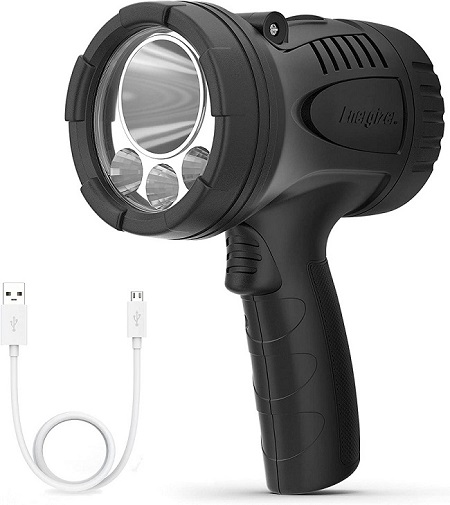
Having a flashlight, floodlight, or headlamp serves two purposes: 1) it’s a backup light in case your kayak light gets disconnected, knocked overboard, or runs out of battery, and 2) it helps you to see where you’re going.
It’s not only about identifying your kayak to other vessels, but making sure you can spot any potential dangers (be they other watercraft, underwater obstacles, or obstacles above the surface) before you collide with them. Plus, a powerful light can help you navigate and stay on course, reducing your chances of getting lost at night.
Item #2: PFD
You should never go kayaking without PFD! It doesn’t matter if it’s day time or night time, you always have to have your lifejacket/vest handy. It’s just the smart thing to do, and keeps you exponentially safer.
Good PFD for night kayaking will have high-visibility and reflective strips on it, making you more visible to other watercraft and anyone on shore.
We’ve compiled a complete list of the Best Kayaking PFD to help you find the lifejacket that suits your needs best.
Item #3: Whistle
A whistle is a cheap, easily portable item, but what a huge difference it can make!

Remember how one of the perks of kayaking at night is that everything is so much quieter and calmer? Well, imagine how much more audible that piercing, whistling shriek will be in all quietness. It’s pretty much guaranteed that someone will hear you, even a long way from the shore.
The sound of a whistle is a fairly universal sign that someone is in danger, so people will instantly be on the alert and trying to identify the source of the sound. In case of capsize, your chances of getting rescued are exponentially higher with a whistle on your PFD or tethered to your kayak.
Note: If you really want to go for maximum noise, consider an airhorn as well as a whistle. That’s a sound that will travel for miles!
Item #4: Compact Flares
Flares are an instantly and highly visible means of letting passing watercraft, people on shore, or rescue vehicles (boats and aircraft) know that you’re in trouble. Roadside flare-type flares that just emit a bright, steady flame are great if you’re near shore, but for off-shore trips, you can always opt for the rocket-style parachute flares that shoot high into the sky and hang in the air for minutes at a time.
There are many waterproof flares that can come in very handy if you’re in need of rescuing after dark!
I’m a fan of high-tech devices that make navigation easier, which is why I always pack a GPS device on my kayak (even during the day). That way, it’s a simple matter to find my way back to shore/my launch point no matter how far out (or off-course) I go.
At night, navigation tools are even more important. Because you can’t see much in the darkness, you may have no idea how far off-shore you are or how far you are from your launch point. There are often few navigational markers visible to help guide you back to safety. Unless you’re an expert at wayfinding by reading the stars (which is a very cool, if rare, skill), you’ll want a GPS device to keep you on track.
Of course, if you want to go old-school, a compass works just fine, too. You can easily find light-up marine compasses that are visible even after dark, and they can be the guide to bring you safely home (provided you know how to read them).
Item #6: Knife
A knife is the sort of EDC (everyday carry) item you should always pack for any outdoor adventure, but it becomes even more important when kayaking at night. A knife will be useful to cut ropes, guy lines, spray skirts, or anything that could trap you inside the kayak in case of emergency situation. With a knife, you can even fend off underwater predators or have a greater chance of survival if you end up swimming to shore in a deserted area.
You don’t need a fancy knife—really just something with a sharp, sturdy blade and a way to clip it onto your PFD is more than enough.
Item #7: Water-Activated Light

Water-activated lights are truly amazing devices! Basically, they’re little lights (strobe or steady) that A) turn on when they make contact with the water, and B) float on the water’s surface to make sure they’re always visible.
They’re typically designed to clip onto your PFD, meaning they’re a hands-free safety solution that could save your life in an emergency. Even if you lose your headlamp, flashlight, floodlight, or kayak-mounted white light, the water-activated light secured to your PFD will still make you visible to rescue personnel.
Item #8: Warm Clothes
When paddling at night, you’re going to be dealing with cooler water and air temperatures. The water temperature won’t drop significantly (most oceans and lakes tend to stay fairly consistent around the clock), but the air temperature will. Add in cold wind and rain, and you’ve got a significantly higher chance of hypothermia.
Which is why you need to bring/wear warm clothes! An extra layer or two covering your torso, an extra thermal layer to protect your legs, extra-warm socks, and a hat and waterproof gloves will likely be more than enough to keep you warm through your night paddle. Check out post about the Ultimate Dress Code for Paddlers.
Of course, if you really want to go for maximum warmth, you can always wear a wetsuit (if you expect to end up in the water) or a drysuit (if you expect strong winds and choppy surf).
Item #9: Spare Clothes
This is one thing you may not think to bring, and likely won’t need 99% of the time. But on that 1%-of-the-time occasion, you’ll be absolutely glad you had them handy!
You’re already dressed warmly enough to stay toasty in cold temperatures and high winds, and you may even be wearing waterproof clothing to protect you from spray and rains. But what happens if you end up capsizing or having to swim back to shore? You get back to your vehicle/house/tent all soaked and cold, with nothing warm and dry to change into?
Ahh, but with a bit of forethought, you can pack some extra clothing into a dry bag, keep them in your kayak’s store compartment, and you’ve got everything you need to be comfortable and warm when you’re back on shore, no matter what happens!
Item #10: First Aid Kit
A first aid kit is a must-have for any sport or outdoor adventure! All the best precautions in the world won’t stop you from getting cut, blisters forming, or rubbing something raw—it’s just the nature of activity in general.
Having the basic first aid items (Band-Aids, medical gauze, hydrogen peroxide, etc.) handy ensures you’ve got the means to treat any wounds, injuries, or cuts you sustain while paddling.
Note: It’s also a good idea to have the contact information for your local search-and-rescue services, emergency services, and Coast Guard, just in case you need it.
Item #11: Spare Paddle
A spare paddle is the sort of item you want to have handy, because once you need it, boy, you really need it!
Your existing paddle will give you many years of faithful use, so you might feel like there’s no need to pack a spare. But all of that can change in an instant!
For example:
- You might need to use it to fend off passing watercraft or push yourself off an obstacle, which could snap the shaft or paddle head.
- You could lose it when you capsize/overturn.
- You might drop it into the water in a moment of inattention, and never be able to find it again in the dark.
- You could use it to fight off an underwater predator (SHARK ATTACK!!!) and it ends up broken or damaged.
Sure, some of these circumstances sound extreme (even far-fetched), but the whole point of being prepared for anything is BEING PREPARED FOR ANYTHING. The last thing you want is to find yourself stranded in the middle of a lake, far downriver, or way out in the ocean without a paddle. A spare paddle is the back-up plan you hope you’ll never have to use, but will be very glad you had it if/when you do.
Item #12: Bilge Pump
When paddling after dark, you need to be more prepared than ever to self-rescue. The darkness will hide you from passing watercraft or people on shore, which means you can’t easily get help in case of emergency.
One of the most crucial self-rescue skills to develop is to right an overturned kayak and remount. It’s a fairly easy task with a sit-on-top kayak, but sit-in kayaks are much harder to right and remount. Even once you do, you’ve still got a cockpit filled with water, which makes paddling back to shore exhausting and increases your risk of overturning/capsizing again.
That’s where a bilge pump comes in handy! Once you’ve righted and remounted the kayak, you can use the pump to drain all the water from the sit-in kayak’s cockpit. With the cockpit once again empty, you’re back to “normal” (efficient) paddling, and you’re much safer on your way back to shore. Keep a bilge pump in one of your kayak storage compartments—it’s another safety device you’ll be glad you have when the time comes that you need it.
Item #13: Walkie-Talkies
Walkie-talkies aren’t your standard kayaking gear, but they can be very useful if you plan on doing night kayaking. They give you an easy way to communicate with people on shore (provided you stick within their range) and let them know your location, course, heading, or if you’re in need of help.
You can also use them to communicate with other members of your paddling party if you’re night kayaking as a group. That way, no one ends up veering too far off-course, and you can talk with your paddling buddies without having to shout over the sound of the wind, waves, and splashing paddles.
Check out our article on the Best Waterproof Walkie-Talkies to find out which walkie talkies are the most reliable, have the best range and battery life, and are the ideal choice for your night kayaking plans!
Tips for Safe, Smart Night Kayaking

By now, you’re probably feeling pretty confident with all the preparations you’ve made and precautions you’ve taken to kayak safely at night. But before you head out for an after-dark paddling session, take these tips to heart:
Check the tides and weather beforehand
Make sure you know what sort of weather to expect—cloudy, rainy, clear, or windy—as well as the ocean/river tides that you’ll encounter along the way. A few minutes spent researching the tides and checking the weather can save you a lot of struggle once you’re out paddling.
Create a “float plan” and STICK WITH IT
A “float plan” is a general plan for where you’re going to float/paddle, the amount of time you’ll be out on the water, where you’ll go and how long it will take to get there, and any other details involved in the trip. It’s worth taking a few minutes before you get in and start paddling to talk about your float plan—either with your fellow kayakers, or if you’re flying solo, someone at home/on shore. That way, you’ve got a good idea of what to expect, and someone knows where you’ll be/where you’re going.
At all costs, try to stick with your float plan as much as possible. Stay on your original course so that if someone has to send help, they’ve got an idea of where to start looking.
Always Be Visible
The minimum legal requirement for night paddling is a white light mounted on your kayak, but don’t just settle for the minimum. Make sure you’re as visible as possible to passing watercraft and have maximum visibility by using multiple headlamps, floodlights, and flashlights on top of your mounted kayak light. It’s not just about safety, but convenience, too.
Paddle Your Route Ahead of Time
Never try a brand new route for the first time in the dark! In the dark, you won’t know where the dangers are, so you won’t know how to avoid them. Make sure to paddle it at least once in broad daylight so you have a good idea of what to watch out for and what obstacles/dangers to steer clear of.
Choose the Safest Route
With night kayaking, you’ve got a much lower chance of seeing dangers with time enough to avoid them. So it makes sense to choose the safest possible route with the fewest obstacles/dangers to be avoided. Stick with easy, beginner-friendly paddling paths—be they ocean, lake, or river—after dark, and keep the tricky paths for broad daylight when you can see where you’re going and what might threaten your safety.
Be Wary of Waves
At night, the moonlight and starlight can play tricks with your eyes, causing you to misjudge/miscalculate wave height if you’re staring directly at the swell. Ideally, you want to look about 20 degrees off-center—either to your right or left—for the most accurate view of the waves. This way, the rod cells concentrated along the outer edges of your eyes will get the clearest view of the low-light environment (it’s real science!).
Be Ready for Anything
Don’t spend your entire trip worrying about invisible dangers, but be prepared for anything (underwater and above-the-surface obstacles, passing watercraft, the shoreline invisible in the darkness, even sea creatures) and always on the alert. Don’t relax your vigilance until you’re safely back on shore.
Don’t Bring New Gear
Save anything new for daytime paddling, when you can easily see what you’re doing and have an easier time mastering it. Stick with the tried-and-true gear that you’ve been using for months/years to make sure you’re paddling as safely and efficiently as possible.
Be Willing to Cancel
Yes, it’s not ideal, but sometimes it has to be done! As much as you want to hit the water for a night kayaking trip, there will be situations or conditions where it’s not ideal or even unsafe. Poor equipment condition, missing or broken gear, excessive fatigue/hunger/thirst, sickness, and inclement weather are all valid reasons that you should probably skip the paddling trip for now.
With the right precautions and preparations, you can enjoy the heck out of kayaking at night and still be as safe as possible!


